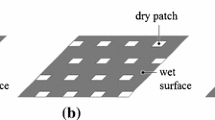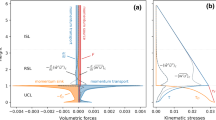Abstract
Natural shelterbelts, unlike planar barriers, have a certain width, within which interactions among wind speed, drag force and pressure perturbations create a net sheltering effect. The variations of flow, drag force, permeability, and pressure perturbation for shelterbelts of different widths and different horizontal structures are numerically studied, and their influences on shelter efficiency are discussed. Comparisons are made of fourteen medium-dense shelterbelts, with the same overall leaf-area, that differ only in width or horizontal distribution of leaf-area density. The simulated results are consistent with both field observations and wind-tunnel measurements.
The simulations demonstrate that the total drag force of the entire shelterbelt varies little with changes in width and structure. The results also show that shelter distance and the overall average wind speed reduction decrease only by 15–18% as width increases by a factor of 100, and changes even less for different internal structure. However, width greatly affects the location of minimum wind speed, pressure perturbation, and the permeability of shelterbelts. Horizontal changes of wind speed inside the uniform shelterbelts have four different patterns, which depend on shelterbelt width and height. The absolute pressure perturbation significantly decreases with increasing width. A possible cause of the insensitivity of shelter efficiency to width and internal inhomogeneous structure is the compensation between the effects of permeability and pressure perturbation on shelter efficiency.
Similar content being viewed by others
References
Bradley, E. F. and Mulhearn, P. J.: 1983, ‘Development of Velocity and Shear Stress Distributions in the Wake of a Porous Shelter Fence’, J. Wind Eng. Ind. Aerodyn. 15, 145–156.
Finnigan, J. J. and Bradley, E. F.: 1983, ‘The Turbulent Kinetic Energy Budget Behind a Porous Barrier: an Analysis in Streamline Coordinates’, J. Wind. Eng. Ind. Aerodyn. 15, 145–156.
Hagen, L. J., Skidmore, E. L., Miller, P. L., and Kipp, J. E.: 1981, ‘Simulation of Effect of Wind Barriers on Airflow’, Trans. ASAE 24, 1002–1008.
Heisler, G. M. and DeWalle, D. R.: 1988, ‘Effects of Windbreak Structure on Wind Flow’, Agriculture, Ecosystems and Environment 22/23, 41–69.
Jacobs, A. F. G.: 1984, ‘The Flow Around a Thin Closed Fence’, Boundary-Layer Meteorol. 28, 317–328.
Maki, T.: 1982, ‘Study on Windbreak Nets. (4) Characteristics of Wind speed Profiles near Various Windbreak Nets Obtained by Wind Tunnel Experiments’, J. Agr. Meteorol. (Japan) 38, 123–133.
Mellor, G. L. and Yamada, T.: 1982, ‘Development of a Turbulent Closure Model for Geophysical Fluid Problems’, Rev. Geophys. Space Sci. 20, 851–875.
Naegeli, W.: 1954, ‘The Braking Effect of the Wind by a Large Forest. A Contribution to the Problem of the Width of Shelterbelts’, Berichte 11, Kongress Intern. Union Forestl. Forschungsanstalten, Rome, Firenze.
Nord, M.: 1991, ‘Shelter Effects of Vegetation Belts — Results of Field Measurements’, Boundary- Layer Meteorol. 54, 363–385.
Ogawa, Y. and Diosey, P. G.: 1980, ‘Surface Roughness and Thermal Stratification Effects on the Flow Behind a Two-Dimensional Fence: II. A Wind Tunnel Study and Similarity Considerations’, Atmos. Environ. 14, 1309–1320.
Perera, M. D. A. S.: 1981, ‘Shelter Behind Two-Dimensional Solid and Porous Fences’, J. Wind Eng. Ind. Aerodyn. 8, 93–104.
Plate, E. J.: 1971, ‘The Aerodynamics of Shelter Belts’, Agric. Meteorol. 8, 203–222.
Raine, J. K. and Stevenson, D. C.: 1977, ‘Wind Protection by Model Fences in a Simulated Atmospheric Boundary Layer’, J. Indust. Aerodyn. 2, 159–180.
Sturrock, J. W.: 1969, ‘Aerodynamics Studies of Shelterbelts in Nealand-1: Low to Medium Height Shelterbelts in Mid-Canterbury’, New Zealand J. Sci. 12, 754–776.
Sturrock, J. W.: 1972, ‘Aerodynamics Studies of Shelterbelts in Nealand-2: Medium Height to Tall Shelterbelts in Mid-Canterbury’, New Zealand J. Sci. 15, 113–140.
Takahashi, H.: 1978, ‘Wind Tunnel Test on the Effect of Width of Windbreaks on the Wind Speed Distribution in Leeward’, J. Agr. Meteorol. (Japan) 33, 183–187.
Taylor, P. A.: 1988, ‘Turbulent Wakes in the Atmospheric Boundary Layer’, in: W. L. Steffen and O. T. Denmead (eds.), Flow and Transport in the Natural Environment: Advances and Applications, Springer-Verlag, Berlin, 270–292.
van Eimern, J., Karschon, R., Razumova, L. A., and Robertson, G. W.: 1964, ‘Windbreaks and Shelterbelts’, World Meteorological Organization Technical Note No. 59, pp. 188.
Wang, H. and Takle, E. S.: 1995a, ‘Boundary-Layer Flow and Turbulence near Porous Obstacles. I: Derivation a General Equation Set for a Porous Medium’, Boundary-Layer Meteorol. 74, 73–88.
Wang, H. and Takle, E. S.: 1995b, ‘A Numerical Simulation of Boundary-Layer Flows near Shelterbelts’, Boundary-Layer Meteorol. 75, 141–173.
Wilson, J. D.: 1985, ‘Numerical Studies of Flow Through a Windbreak’, J. Wind Eng. Ind. Aerodyn. 21, 119–154.
Wilson, J. D.: 1987, ‘On the Choice of a Windbreak Porosity Profile’, Boundary-Layer Meteorol. 38, 37–39.
Woodruff, N. P., Read, R. A., and Chepil, W. S.: 1959, ‘Influence of a Field Windbreak on Summer Wind Movement and Air Temperature’, Kansas Agric. Exp. Stn. Tech. Bull. No. 100, 24 pp.
Woodruff, N. P. and Zingg, A. W.: 1953, ‘Wind Tunnel Studies of Shelterbelt Models’, J. Forest 53, 171–178.
Yamada, T.: 1982, ‘A Numerical Model Study of Turbulent Airflow in and Above a Forest Canopy’, J. Meteor. Soc. Japan 60, 438–454.
Author information
Authors and Affiliations
Rights and permissions
About this article
Cite this article
Wang, H., Takle, E.S. On three-dimensionality of shelterbelt structure and its influences on shelter effects. Boundary-Layer Meteorol 79, 83–105 (1996). https://doi.org/10.1007/BF00120076
Accepted:
Issue Date:
DOI: https://doi.org/10.1007/BF00120076




